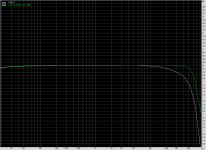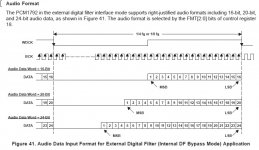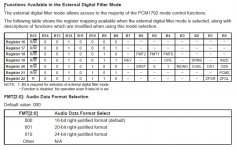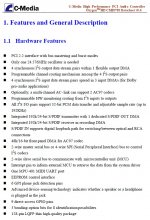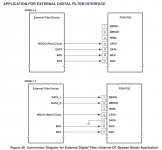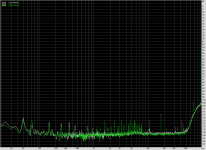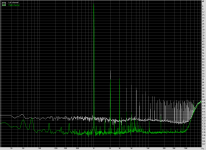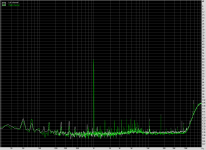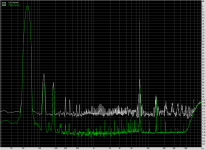Coris, have you tried improving I/V opamp feedback? There's a resistor and maybe capacitor. I was improving this place many months ago but the card was like a stock. Now I improve this and it's amazing! The difference is much bigger than before! I can't move back. Much more details, clearer image and even proper vertical position for some sounds. Distant sounds are so clear on the opamp where it wasn't before.
Any tips?
Any tips?
HT Omega is multimedia peripherals manuf. that supposed makes "high-end" audio cards, too. Their cards are similar to Asus, some say better. HT Omega uses that CMI8788 decoder specifically, not re-badged. Still confused as to why you brought the reclocker CS2000 into the disc. -- specifically what it has to do with parametric control that the 1792 offers.
Anyway, the 1792 is thought to be a better (tho' older) version of the 179x family. See this link for 1792 vs 1796 diffs.
EDIT: The Claro Halo XT by HT Omega card is here:
http://www.htomega.com/clarohalo_xt.html
It's similar to Xonar (same OEM??) but uses a AKM DAC.
Anyway, the 1792 is thought to be a better (tho' older) version of the 179x family. See this link for 1792 vs 1796 diffs.
EDIT: The Claro Halo XT by HT Omega card is here:
http://www.htomega.com/clarohalo_xt.html
It's similar to Xonar (same OEM??) but uses a AKM DAC.
Last edited:
The CS2000 is used on the Xonar Essence ST cards. Not on the STX. You can't control directly the PCM1792 from the Windows driver. You can control the CMI8788 and tell it to send the data to the I2C. It may seem easy to me as I already designed one DAC and wrote a driver from scratch with the ATMega doing also a lot of different work. Humanoidal machine, jaw movement and wrote speech synthesis with my voice.
Going back to the topic: I'll ask the unixonar driver programmer for some help here.
Going back to the topic: I'll ask the unixonar driver programmer for some help here.
Corvus5: I posted on this topic in the dedicated thread a few days back ...
If we can adapt TI's demo software (or similar) -- via ad hoc drivers, etc -- to directly control 1792, then this would be a good thing. E.g., being able to take advantage of ASIO and play with 1792's useful parameters like filter selection, sample rate, etc.
If we can adapt TI's demo software (or similar) -- via ad hoc drivers, etc -- to directly control 1792, then this would be a good thing. E.g., being able to take advantage of ASIO and play with 1792's useful parameters like filter selection, sample rate, etc.
1792's filter option
 I want whatever results when 1792's datasheet-specified filter for slow or fast is selected. I'm hoping that "slow" will improve time-domain performance (hard to tell w/o impulse test). Also 1792 allows software to turn digital filter off, as prev. suggested, so one can use external DF. This should be interesting as one may be able to NOS it.
I want whatever results when 1792's datasheet-specified filter for slow or fast is selected. I'm hoping that "slow" will improve time-domain performance (hard to tell w/o impulse test). Also 1792 allows software to turn digital filter off, as prev. suggested, so one can use external DF. This should be interesting as one may be able to NOS it.
Do you have a contact inside Asus? It would be nice to incorporate all this into the default Audio Control Center.
Oh ... BTW ... did you ever do 44.1 vs 192k sample rate graphs?
NoI'll take a look. Do you wish to get something like this?
Do you have a contact inside Asus? It would be nice to incorporate all this into the default Audio Control Center.
Oh ... BTW ... did you ever do 44.1 vs 192k sample rate graphs?
No, I don't.Do you have a contact inside Asus? It would be nice to incorporate all this into the default Audio Control Center.
Yes, a lot. What would you like to see on them? The hard part is the noise which changes in time. It may be due to temperature change even if it's a few degree change. The current setup has some THD present and is very quiet. If I wanted to get very good results on paper, I would stick to the original topology. Too bad it does not sound good.Oh ... BTW ... did you ever do 44.1 vs 192k sample rate graphs?
Digital flter can be done turned off. Problem is data format which must be selected after.
"The PCM1792A in the external digital filter interface mode supports right-justified audio formats including 16-bit, 20-bit, and 24-bit audio data".
CMI8788 chip supports only I2S format for audio digital data. We can not use this CMI chip with PCM1792 with disabled internal digital filter in pcm.
"The PCM1792A in the external digital filter interface mode supports right-justified audio formats including 16-bit, 20-bit, and 24-bit audio data".
CMI8788 chip supports only I2S format for audio digital data. We can not use this CMI chip with PCM1792 with disabled internal digital filter in pcm.
You're wrong. It's the format for the digital filter. If you disable the filter, you use external one. There are:Digital flter can be done turned off. Problem is data format which must be selected after.
"The PCM1792A in the external digital filter interface mode supports right-justified audio formats including 16-bit, 20-bit, and 24-bit audio data".
CMI8788 chip supports only I2S format for audio digital data. We can not use this CMI chip with PCM1792 with disabled internal digital filter in pcm.
- WDCK (word clock)
- DATA_L
- DATA_R
- BSCK
- SCK
And the format you've said is used for the filter, not the PCM1792 data source. These are different lines. I see no problem.
Why Sample Rate matters
My recent change to Sample Rate = 192k (from 44.1) was an important sonic upgrade. I would put it on par with an op-amp upgrade. I don't know how graphs of the two appear. If you have them, handy please post. I would do it myself but, like some others, I can't get RMAA to install on my Win XP computer.Yes, a lot. What would you like to see on them? The hard part is the noise which changes in time. It may be due to temperature change even if it's a few degree change. The current setup has some THD present and is very quiet. If I wanted to get very good results on paper, I would stick to the original topology. Too bad it does not sound good.
Asus contact info for suggestions
I filled out the form here ...
https://vip.asus.com/VIP2/Services/TechQuery/?lang=en-us
...with a brief message suggesting Asus to update their Control Center with more advanced and direct control of PCM1792, incl. filter sharp/slow (select); filter defeat; output phase reversal.
Also, they might look into offering addit. filters -- e.g., Min. Phase and Apodizing -- programmed into the AV100 DSP.
I referred them to this and other topical threads of Xonar users interested in these features. Asus replied that they're looking into it. Alas, only one lone voice won't be enough ... so fill out that form, folks.
Thx!
I filled out the form here ...
https://vip.asus.com/VIP2/Services/TechQuery/?lang=en-us
...with a brief message suggesting Asus to update their Control Center with more advanced and direct control of PCM1792, incl. filter sharp/slow (select); filter defeat; output phase reversal.
Also, they might look into offering addit. filters -- e.g., Min. Phase and Apodizing -- programmed into the AV100 DSP.
I referred them to this and other topical threads of Xonar users interested in these features. Asus replied that they're looking into it. Alas, only one lone voice won't be enough ... so fill out that form, folks.
Thx!
First up option from picture, but it is useless because CMI8788 can not be set to work with PCM chip in BF mode, it is not supported by CMI because unsupported data format.Here's the connection of digital filter to the DAC. Where do you want to plug the CMI8788 here?
Last edited:
How big and which type I/V opamp feedback caps do you recommend? Stock are probably 2.2nF. Changing this value causes small audiable changes. I tried also removing this caps and leaving only resistance. Lower capacitance casuses noises level to increase and introduces larger THD. No cap means THD in whole measurable spectrum (<96kHz). Increasing cap value causes also THD increase, especially 2nd and 3rd harmonics.
Due to lack of caps of this type I use through hole ceramics, 2x1nF. Still noise level is higher and I think the opamp become a little unstable. What's your experience in this matter?
Added pictures: left channel uses new feedback caps. Feedback resistance 250ohm
Due to lack of caps of this type I use through hole ceramics, 2x1nF. Still noise level is higher and I think the opamp become a little unstable. What's your experience in this matter?
Added pictures: left channel uses new feedback caps. Feedback resistance 250ohm
Attachments
Last edited:
This situation happens when the TPA is set for higher gain. Way to deal with it is to not use the gain. Strange, I modify only the I/V section and tried this with 2 different opamps. The same results. The feedback capacitor should match the output capacitance. AFAIK the PCM1792 has the switching frequency of a little more than 400kHz. The current opamp is set to filter ~300kHz. In one application I had the filter at 21kHz. Didn't sound open and airy but wasn't very bad.
Download this software: SPICE-Based Analog Simulation Program - TINA-TI - TI Software Folder
Draw I/V stage to this software. Run "AC transfer charakteristic" and you will see nice graphs.
Draw I/V stage to this software. Run "AC transfer charakteristic" and you will see nice graphs.
- Home
- Source & Line
- PC Based
- Xonar ST/STX mods...
